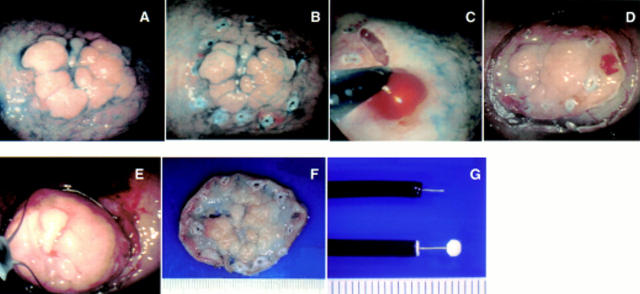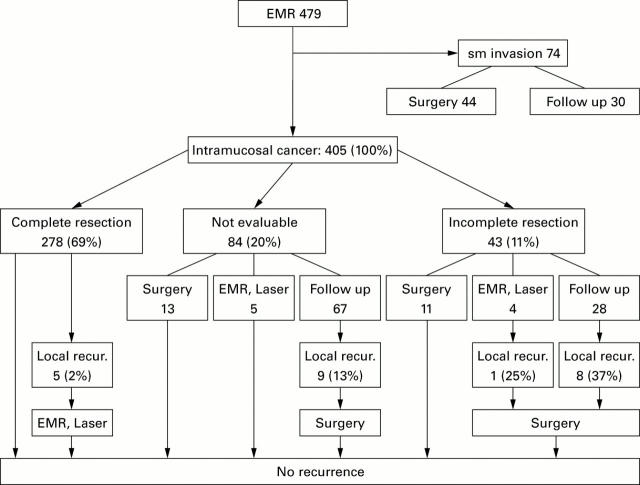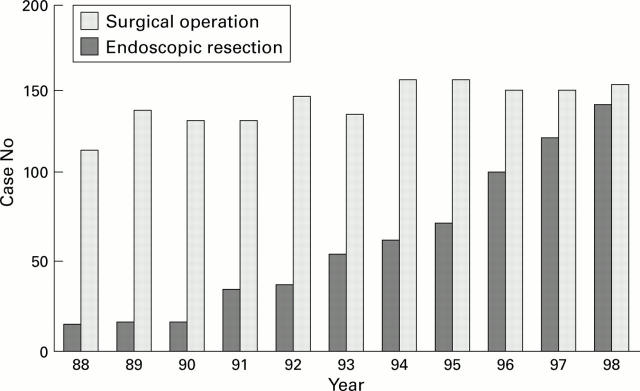Abstract
BACKGROUND—In Japan, endoscopic mucosal resection (EMR) is accepted as a treatment option for cases of early gastric cancer (EGC) where the probability of lymph node metastasis is low. The results of EMR for EGC at the National Cancer Center Hospital, Tokyo, over a 11 year period are presented. METHODS—EMR was applied to patients with early cancers up to 30 mm in diameter that were of a well or moderately histologically differentiated type, and were superficially elevated and/or depressed (types I, IIa, and IIc) but without ulceration or definite signs of submucosal invasion. The resected specimens were carefully examined by serial sections at 2 mm intervals, and if histopathology revealed submucosal invasion and/or vessel involvement or if the resection margin was not clear, surgery was recommended. RESULTS—Four hundred and seventy nine cancers in 445 patients were treated by EMR from 1987 to 1998 but submucosal invasion was found on subsequent pathological examination in 74 tumours. Sixty nine percent of intramucosal cancers (278/405) were resected with a clear margin. Of 127 cancers without "complete resection", 14 underwent an additional operation and nine were treated endoscopically; the remainder had intensive follow up. Local recurrence in the stomach occurred in 17 lesions followed conservatively, in one lesion treated endoscopically, and in five lesions with complete resection. All tumours were diagnosed by follow up endoscopy and subsequently treated by surgery. There were no gastric cancer related deaths during a median follow up period of 38 months (3-120 months). Bleeding and perforation (5%) were two major complications of EMR but there were no treatment related deaths. CONCLUSION—In our experience, EMR allows us to perform less invasive treatment without sacrificing the possibility of cure. Keywords: endoscopic mucosal resection; early gastric cancer
Full Text
The Full Text of this article is available as a PDF (149.8 KB).
Figure 1 .
Endoscopic mucosal resection procedure using an IT knife. (A) Superficial elevated (IIa type) early gastric cancer (EGC) located on the lesser curvature of the lower body after spraying with indigo carmine dye. (B) Marking dots were made using a precut knife on the circumference of the target lesion to clarify the margin. (C) After injection of saline with epinephrine (0.025 mg/ml) into the submucosal layer, an initial cut was made with a conventional needle knife outside of the dots. The IT knife was inserted into this cut and operated to cut around the lesion. (D) The tumour marked by dots was separated from the surrounding normal mucosa. (E) The tumour was removed by standard polypectomy with a combination of cutting and coagulation current in a single fragment. (F) The resected specimen showed well differentiated adenocarcinoma (20×25 mm) with a clear lateral margin. (G) The specifications of the insulation tipped diathermic knife, which was developed by Dr Hosokawa in 1994. The knife consists of a conventional diathermic needle knife (KD-1L; Olympus, Japan) with a ceramic ball at the top to minimise the risk of perforation.
Figure 2 .
Clinical courses after endoscopic mucosal resection (EMR) for early gastric cancer.
Figure 3 .
Trends in treatment for early gastric cancer at the National Cancer Center Hospital.
Selected References
These references are in PubMed. This may not be the complete list of references from this article.
- Everett S. M., Axon A. T. Early gastric cancer in Europe. Gut. 1997 Aug;41(2):142–150. doi: 10.1136/gut.41.2.142. [DOI] [PMC free article] [PubMed] [Google Scholar]
- Gotoda T., Kondo H., Ono H., Saito Y., Yamaguchi H., Saito D., Yokota T. A new endoscopic mucosal resection procedure using an insulation-tipped electrosurgical knife for rectal flat lesions: report of two cases. Gastrointest Endosc. 1999 Oct;50(4):560–563. doi: 10.1016/s0016-5107(99)70084-2. [DOI] [PubMed] [Google Scholar]
- Hirao M., Masuda K., Asanuma T., Naka H., Noda K., Matsuura K., Yamaguchi O., Ueda N. Endoscopic resection of early gastric cancer and other tumors with local injection of hypertonic saline-epinephrine. Gastrointest Endosc. 1988 May-Jun;34(3):264–269. doi: 10.1016/s0016-5107(88)71327-9. [DOI] [PubMed] [Google Scholar]
- Inoue H., Tani M., Nagai K., Kawano T., Takeshita K., Endo M., Iwai T. Treatment of esophageal and gastric tumors. Endoscopy. 1999 Jan;31(1):47–55. doi: 10.1055/s-1999-13647. [DOI] [PubMed] [Google Scholar]
- Japanese Gastric Cancer Association Japanese Classification of Gastric Carcinoma - 2nd English Edition - Gastric Cancer. 1998 Dec;1(1):10–24. doi: 10.1007/s101209800016. [DOI] [PubMed] [Google Scholar]
- Noguchi Y., Imada T., Matsumoto A., Coit D. G., Brennan M. F. Radical surgery for gastric cancer. A review of the Japanese experience. Cancer. 1989 Nov 15;64(10):2053–2062. doi: 10.1002/1097-0142(19891115)64:10<2053::aid-cncr2820641014>3.0.co;2-j. [DOI] [PubMed] [Google Scholar]
- Okamura T., Tsujitani S., Korenaga D., Haraguchi M., Baba H., Hiramoto Y., Sugimachi K. Lymphadenectomy for cure in patients with early gastric cancer and lymph node metastasis. Am J Surg. 1988 Mar;155(3):476–480. doi: 10.1016/s0002-9610(88)80116-8. [DOI] [PubMed] [Google Scholar]
- Sano T., Kobori O., Muto T. Lymph node metastasis from early gastric cancer: endoscopic resection of tumour. Br J Surg. 1992 Mar;79(3):241–244. doi: 10.1002/bjs.1800790319. [DOI] [PubMed] [Google Scholar]
- Sano T., Okuyama Y., Kobori O., Shimizu T., Morioka Y. Early gastric cancer. Endoscopic diagnosis of depth of invasion. Dig Dis Sci. 1990 Nov;35(11):1340–1344. doi: 10.1007/BF01536738. [DOI] [PubMed] [Google Scholar]
- Schlemper R. J., Itabashi M., Kato Y., Lewin K. J., Riddell R. H., Shimoda T., Sipponen P., Stolte M., Watanabe H., Takahashi H. Differences in diagnostic criteria for gastric carcinoma between Japanese and western pathologists. Lancet. 1997 Jun 14;349(9067):1725–1729. doi: 10.1016/S0140-6736(96)12249-2. [DOI] [PubMed] [Google Scholar]
- Tada M., Murakami A., Karita M., Yanai H., Okita K. Endoscopic resection of early gastric cancer. Endoscopy. 1993 Sep;25(7):445–450. doi: 10.1055/s-2007-1010365. [DOI] [PubMed] [Google Scholar]
- Yamao T., Shirao K., Ono H., Kondo H., Saito D., Yamaguchi H., Sasako M., Sano T., Ochiai A., Yoshida S. Risk factors for lymph node metastasis from intramucosal gastric carcinoma. Cancer. 1996 Feb 15;77(4):602–606. doi: 10.1002/(SICI)1097-0142(19960215)77:4<602::AID-CNCR3>3.0.CO;2-I. [DOI] [PubMed] [Google Scholar]
- Yasuda K., Shiraishi N., Suematsu T., Yamaguchi K., Adachi Y., Kitano S. Rate of detection of lymph node metastasis is correlated with the depth of submucosal invasion in early stage gastric carcinoma. Cancer. 1999 May 15;85(10):2119–2123. doi: 10.1002/(sici)1097-0142(19990515)85:10<2119::aid-cncr4>3.0.co;2-m. [DOI] [PubMed] [Google Scholar]





